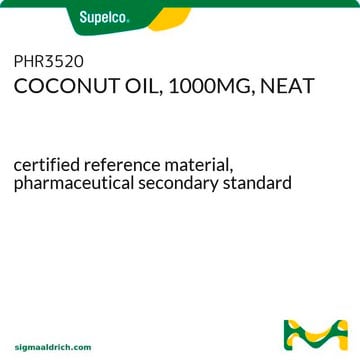C1758
Huile de noix de coco from Cocos nucifera
low-melting solid
Synonyme(s) :
Huile de coprah
Se connecterpour consulter vos tarifs contractuels et ceux de votre entreprise/organisme
About This Item
Numéro CAS:
Numéro CE :
Numéro MDL:
Code UNSPSC :
12352211
Nomenclature NACRES :
NA.25
Produits recommandés
Source biologique
Cocos nucifera
Niveau de qualité
Forme
low-melting solid
Pf
23-27 °C
Type de lipide
oils
Conditions d'expédition
ambient
Température de stockage
room temp
Vous recherchez des produits similaires ? Visite Guide de comparaison des produits
Application
- Linseed, Baru, and Coconut Oils: NMR-Based Metabolomics, Leukocyte Infiltration Potential In Vivo, and Their Oil Characterization. Are There Still Controversies: This research utilizes NMR-based metabolomics to explore the biochemical properties of various oils, including coconut oil, and investigates their potential for leukocyte infiltration in vivo. The findings contribute to understanding the health implications and biochemical interactions of coconut oil (Figueiredo et al., 2022).
Forme physique
Usually a solid at room temperature
Code de la classe de stockage
11 - Combustible Solids
Classe de danger pour l'eau (WGK)
WGK 1
Point d'éclair (°F)
>235.4 °F - closed cup
Point d'éclair (°C)
> 113 °C - closed cup
Équipement de protection individuelle
Eyeshields, Gloves, type N95 (US)
Faites votre choix parmi les versions les plus récentes :
Déjà en possession de ce produit ?
Retrouvez la documentation relative aux produits que vous avez récemment achetés dans la Bibliothèque de documents.
Les clients ont également consulté
Ryan Pannorfi et al.
Physiological and biochemical zoology : PBZ, 85(4), 405-414 (2012-06-19)
Heterothermic rodents increase self-selection of diets rich in polyunsaturated fatty acids (PUFAs) when exposed to cold, short days, or short-day melatonin profiles, and Djungarian hamsters (Phodopus sungorus) do so in long days in response to cold exposure alone. To determine
Young Taek Oh et al.
Physiology & behavior, 167, 194-201 (2016-10-25)
Previous rodent studies showed that when injected into the brain, free fatty acids (FFAs) reduced food intake in an oleate-specific manner. The present study was performed to test whether food intake is regulated by circulating FFAs in an oleate-specific manner.
Xuezhi Ding et al.
Tropical animal health and production, 44(7), 1541-1545 (2012-03-01)
The objective was to evaluate the effect of dietary coconut oil on methane (CH(4)) emissions and the microbial community in Tibetan sheep. Twelve animals were assigned to receive either a control diet (oaten hay) or a mixture diet containing concentrate
Jingcan Sun et al.
Food chemistry, 141(3), 2828-2832 (2013-07-23)
Ester synthesis was carried out in a solvent-free system of lipase, coconut oil and ethanol or fusel alcohols to ascertain the reaction mechanism. During ester formation, octanoic and decanoic acids increased initially and then decreased gradually, indicating that ester production
C Reveneau et al.
Journal of dairy science, 95(4), 2061-2069 (2012-03-31)
Feeding animal-vegetable (AV) fat or medium-chain fatty acids (FA) to dairy cows can decrease ruminal protozoal counts. However, combining moderate to large amounts of AV fat with monensin (tradename: Rumensin, R) could increase the risk for milk fat depression (MFD)
Notre équipe de scientifiques dispose d'une expérience dans tous les secteurs de la recherche, notamment en sciences de la vie, science des matériaux, synthèse chimique, chromatographie, analyse et dans de nombreux autres domaines..
Contacter notre Service technique








